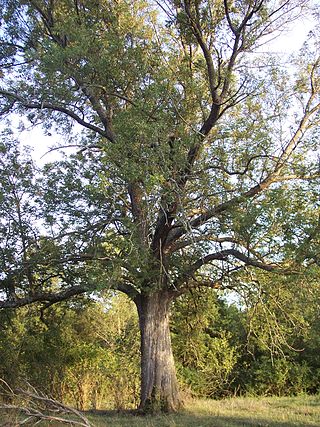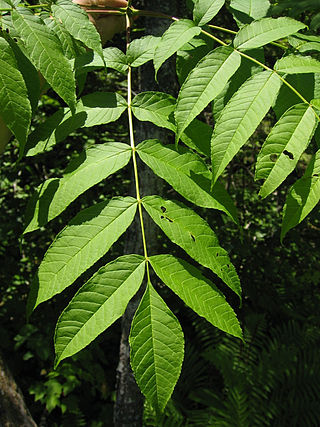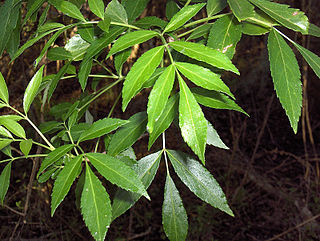
Fraxinus, commonly called ash, is a genus of plants in the olive and lilac family, Oleaceae, and comprises 45–65 species of usually medium-to-large trees, most of which are deciduous trees, although some subtropical species are evergreen trees. The genus is widespread throughout much of Europe, Asia, and North America.

Fraxinus quadrangulata, the blue ash, is a species of ash native primarily to the Midwestern United States from Oklahoma to Michigan, as well as the Bluegrass region of Kentucky and the Nashville Basin region of Tennessee. Isolated populations exist in Alabama, Southern Ontario, and small sections of the Appalachian Mountains. It is typically found over calcareous substrates such as limestone, growing on limestone slopes and in moist valley soils, at elevations of 120–600 m.

Fraxinus americana, the white ash or American ash, is a species of ash tree native to eastern and central North America.

Ptelea trifoliata, commonly known as common hoptree, wafer ash, stinking ash, and skunk bush, is a species of flowering plant in the citrus family (Rutaceae). It is native to North America, where it is found in Canada, Mexico, and the United States. It is a deciduous shrub or tree, with alternate, trifoliate leaves.

Fraxinus pennsylvanica, the green ash or red ash, is a species of ash native to eastern and central North America, from Nova Scotia west to southeastern Alberta and eastern Colorado, south to northern Florida, and southwest to Oklahoma and eastern Texas. It has spread and become naturalized in much of the western United States and also in Europe from Spain to Russia.

Fraxinus latifolia, the Oregon ash, is a member of the ash genus Fraxinus, native to western North America.

Fraxinus nigra, the black ash, is a species of ash native to much of eastern Canada and the northeastern United States, from western Newfoundland west to southeastern Manitoba, and south to Illinois and northern Virginia. Formerly abundant, as of 2014 the species is threatened with near total extirpation throughout its range, as a result of infestation by a parasitic insect known as the emerald ash borer.

Fraxinus angustifolia, the narrow-leaved ash, is a species of Fraxinus native to Central Europe and Southern Europe, Northwest Africa, and Southwest Asia.

Chionanthus virginicus is a tree native to the savannas and lowlands of the northeastern and southeastern United States, from Massachusetts south to Florida, and west to Oklahoma and Texas.

Fraxinus mandshurica, the Manchurian ash, is a species of Fraxinus native to northeastern Asia in northern China, Korea, Japan and southeastern Russia.

Fraxinus dipetala, the California ash or two-petal ash, is a species of ash native to southwestern North America in the United States in northwestern Arizona, California, southern Nevada, and Utah, and in Mexico in northern Baja California. It grows at altitudes of 100–1,300 m.

Fraxinus profunda, the pumpkin ash, is a species of ash (Fraxinus) native to eastern North America, where it has a scattered distribution on the Atlantic coastal plain and interior lowland river valleys from the Lake Erie basin in Ontario and New York west to Illinois, southwest to Missouri and southeast to northern Florida. It grows in bottomland habitats, such as swamps, floodplains and riverbanks. It is threatened by the emerald ash borer, an invasive insect which has caused widespread destruction of ash trees in eastern North America.

Fraxinus velutina, the velvet ash, Arizona ash or Modesto ash, is a species of Fraxinus native to southwestern North America, in the United States from southern California east to Texas, and in Mexico from northern Baja California east to Coahuila and Nuevo León.

Fraxinus lanuginosa is a species of ash native to Japan and to the Primorye region of eastern Russia.

Fraxinus caroliniana, the pop ash, Florida ash, swamp ash, Carolina ash, or water ash, is a species of ash tree native from Cuba through the subtropical Southeastern United States from southern Virginia to Texas. It was originally described by the botanist Philip Miller. It is a small tree about 40 ft. Leaves are compound, opposite, 7–12 in long, leaflets 5–7 in, ovate to oblong, coarsely serrate or entire, 3–6 in long, 2–3 in wide. Fruit is frequently 3-winged (samara) with flat seed portion; seed sometimes a bright violet color. It is the smallest of eastern North American ash species, wood light, soft, weak, 22 lbs./cu.ft. Typical to coastal swamps and subtropical lowlands. Like other species in the section Melioides, Fraxinus caroliniana is dioecious, with male and female flowers produced on separate individuals.

Buchnera americana, commonly known as American bluehearts or bupleurum, is a locally endangered herbaceous perennial plant of the broomrape family Orobanchaceae. Found widely across the eastern United States, it also occurs in one location in the Canadian province of Ontario.
Fraxinus berlandieriana, the Mexican ash, is a tree native to eastern and northeastern Mexico and to the south-central United States. It has been reported from Tamaulipas, Veracruz, Texas, New Mexico, Oklahoma, Louisiana and Mississippi.

Fraxinus chinensis, the Chinese ash, is a species of flowering trees. Its leaves are used in traditional Chinese medicine for dysentery disorders.

Fraxinus uhdei, commonly known as tropical ash or Shamel ash, is a species of tree native to Mexico and Central America. It is commonly planted as a street tree in Mexico and the southwestern United States. It has also been planted and spread from cultivation in Hawaii, where it is now considered an invasive species.

Fraxinus parryi, known by common names chaparral ash, crucecilla, and fresnillo, is a species of ash native to southwestern North America, growing as a shrub or a small tree.





















